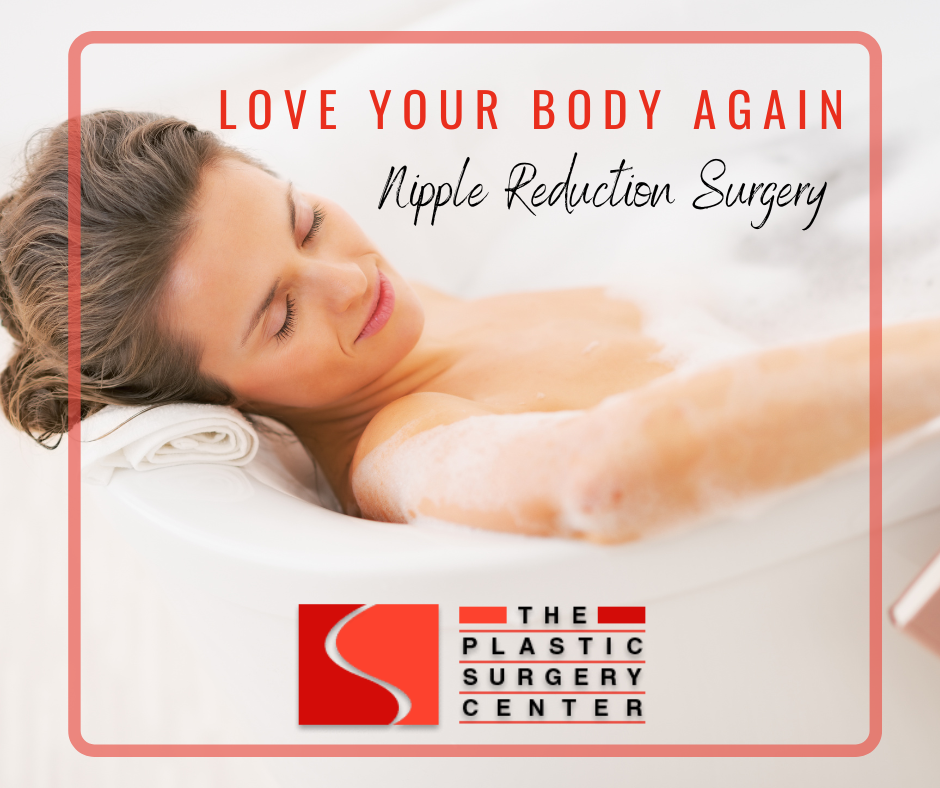NIPPLE REDUCTION SURGERY
Procedures
Nipple Reduction in Shreveport, LA
Anatomy
The nipple is the small projection that is located in the center of the breast. The areola is the more pigmented area around the nipple. The Nipple Areola Complex, or NAC, plays a huge role in the overall breast aesthetics. Its shape, size, positioning, and location varies significantly from patient to patient, which makes the surgery more customizable.
Sometimes, simply correcting oversized nipples, puffy areolas, or both is all that a patient needs to improve their breasts’ appearance. This actually happens a lot more often than you’d think (for both men and women). These specific conditions can be caused by hormones, genetics, trauma, or aging.
Many patients decide to undergo a nipple reduction procedure because they feel self conscious, while other patients, more specifically, moms, need to undergo a nipple reduction procedure to help correct breastfeeding problems.
Reasons for a Areola Reduction Procedure
Puffy Areolas
A puffy areola is typically caused by the breast tissue pushing the areola forward. This specific condition is seen in tuberous breasts, which is a genetic condition that creates an elongated or tubular breast appearance. Puffy areolas can be addressed with a simple areola reduction surgery with or without an accompanying tubular breast correction surgery.
Asymmetrical Areolas
If one areola is larger than the other, this can be corrected through a simple areola reduction, as well. In this case, Dr. Wall would reduce the size of the larger areola to match the size of the smaller one, making them more symmetrical.
Noncircular Areolas
Typically, areolas are circular in shape. But, for some patients, the areolas are oval or abnormally shaped. Dr. Wall can address this issue through an areola surgery.
Reasons for a Nipple Reduction Procedure
Inverted Nipples
Inverted nipples are a condition in which the nipple retracts into the breasts, as opposed to facing outwards. This condition causes the milk ducts to tether. Some patients may see this condition reverse when the nipples are stimulated, while others experience the inverted nipple condition all of the time.
Nipple inversion can be caused by sagging breasts, breastfeeding, or genetics.
To correct this, Dr. Wall makes a small incision at the base of the nipple. This releases the fibers that surround the milk ducts, stopping them from pulling down on the nipple.
Enlarged Nipples
Enlarged nipples, or nipple hypertrophy, causes the nipples to appear droopy as well as either long, wide, or both. It typically presents as disproportionately large nipples, for most patients. Hypertrophic nipples can occur in both sagging breasts or perky breasts.
In order to correct hypertrophy, Dr. Wall removes a portion of the nipple during a nipple reduction procedure, creating a more desirable size and shape.
Lack of Nipples
While this isn’t technically considered a “nipple reduction procedure,” Dr. Wall can perform nipple reconstruction for both men and women who lack nipples.
This condition is most often seen after a mastectomy or trauma to the breast area, but for some, this may be congenital.
Dr. Wall can use a few different techniques to reconstruct a patient’s nipple including cartilage grafts, skin grafts, and tissue flaps.
You will need to meet for a consultation to see if you’re a candidate for nipple reconstruction surgery.

Am I a Candidate for a Nipple Reduction Breast Augmentation?
You should be a good candidate for a nipple reduction or areola reduction surgery if you are in overall good health and wish to reduce the size of your nipple or areola.
This includes the desire to reduce the diameter of your areola area or the length of your nipple area.
We recommend that women wait until they are done having children to undergo this surgical correction, as pregnancy and breastfeeding can potentially stretch out the areola and nipple. However, if you have had trouble breastfeeding in the past and believe that this surgical reduction can improve your ability to breastfeed, consult with your OBGYN (or prior OBGYN).
Areola Reduction or Nipple Reduction Consultation
During your private consultation with Board certified plastic surgeon, Dr. Forrest Wall, you will express your aesthetic goals. Dr. Wall will then perform a breast examination and determine if this cosmetic reduction will fulfill those goals.
If you’re a candidate for areola or nipple reduction surgery, then he will discuss all of your options with you. He will go over the surgical procedure, the areola or nipple reduction techniques he will use, and ancillary procedures.
You will understand what happens before, during, and after the surgical procedure before leaving the office.
Areola Reduction and Nipple Reduction Procedure
Both areola reduction procedures and nipple reduction procedures are performed under local anesthesia. These are both outpatient procedures. While there are standard reduction techniques that Dr. Wall uses to perform the nipple reduction and areola reduction surgeries, each patient is unique. Each patient receives a custom technique to ensure optimal results.
Nipple reduction and areola reduction usually takes an hour when there aren’t additional plastic surgery procedures.
Nipple Reduction Procedure
During the nipple reduction procedure, the nipple remains attached to the body, leaving the native blood supply uninterrupted. Based on your goals and genetic makeup, Dr. Wall can preserve the milk ducts, thus preserving your ability to breastfeed in the future.
It’s important to note that not all females are able to breastfeed, regardless of whether or not they’ve undergone a breast augmentation.
Inverted Nipple Correction
During the inverted nipple correction procedure, Dr. Wall will make a small incision near the nipple base. This allows him access to the internal fibers that pull your nipple inward. He releases these fibers, and then sutures the incision.
Areola Reduction Procedure
During the areola reduction procedure, the milk ducts and blood supply remains intact as well. Dr. Wall uses a purse string suture technique to ensure longer lasting results. This technique uses two circular and concentric incisions to create the desired areola size.
Dr. Wall removes the excess breast tissue around the areola, while the nipple is untouched
This technique can also have an added slight breast lift benefit.

Areola and Nipple Reduction Recovery
Since this plastic surgery option is an outpatient procedure, patients are able to go home right after their surgery. And, typically, patients are able to return to work the following day. We recommend that after the plastic surgery, patients walk regularly to encourage blood flow.
Dr. Wall covers the incisions with a thin film of antibiotic ointment and a thin piece of gauze. Patients need to clean the gauze at least once a day to keep the incisions clean.
You may experience a slight adverse nipple sensation or slight bruising for the first week. This can be easily managed with pain medication.
We recommend that you avoid strenuous activity or sexual activity for the first few weeks to ensure that your results aren’t compromised.
Corresponding and Complementary Breast Procedures
In addition to areola reduction and nipple reduction procedures, Dr. Forrest Wall provides many other corresponding and complementary procedures. We can discuss the following during your initial consultation:
Our office accepts Care Credit and works with various insurance providers for procedures that are covered under your insurance policy.
